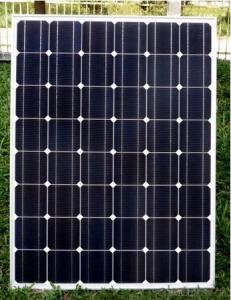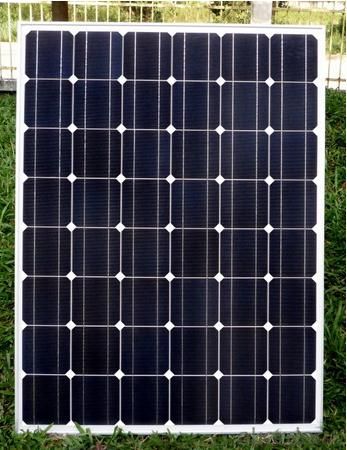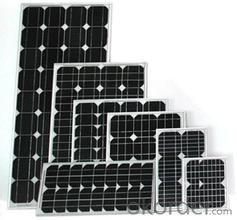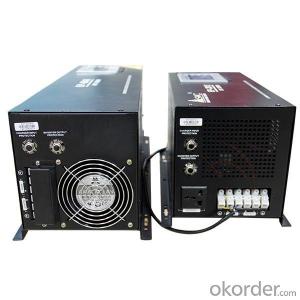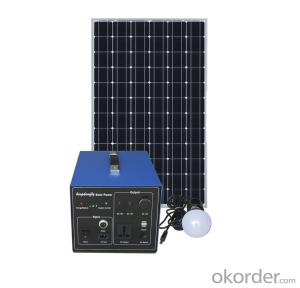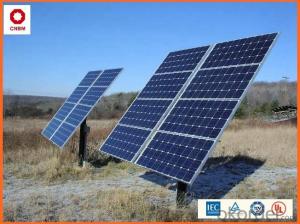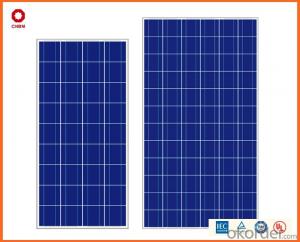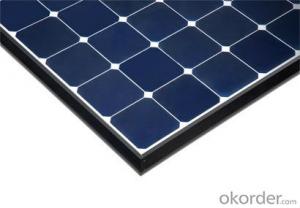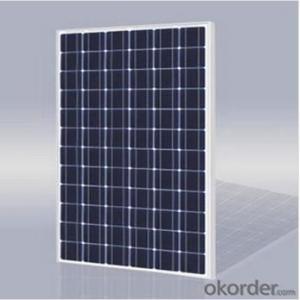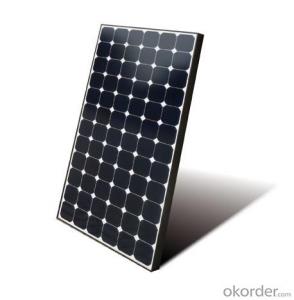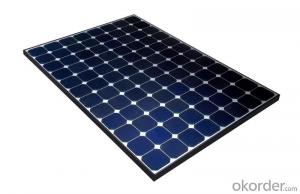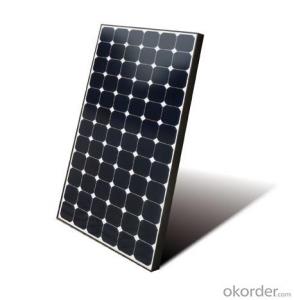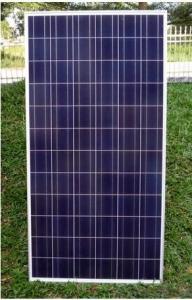Active and Passive Solar Energy Systems - CNBM On Grid System 6000W with Certificate UL TUV CE
- Loading Port:
- Shanghai
- Payment Terms:
- TT OR LC
- Min Order Qty:
- 100 watt
- Supply Capability:
- 1000 watt/month
OKorder Service Pledge
OKorder Financial Service
You Might Also Like
Specification
CNBM On Grid System 6000W with Certificate UL TUV CE
Product description
They range from small residential and commercial rooftop systems to large utility-scale solar power stations. Unlike stand-alone power systems, a grid-connected system rarely includes an integrated battery solution, as they are still very expensive. When conditions are right, the grid-connected PV system supplies the excess power, beyond consumption by the connected load, to the utility grid.
Connection of the photovoltaic power system can be done only through an interconnection agreement between the consumer and the utility company. The agreement details the various safety standards to be followed during the connection.[4]
Systems such as Net Metering and Feed-in Tariff which are offered by some system operators, can offset a customers electricity usage costs. In some locations though, grid technologies cannot cope with distributed generation feeding into the grid, so the export of surplus electricity is not possible and that surplus is earthed.
Grid-connected PV systems are comparatively easier to install as they do not require a battery system.[1][6]
Grid interconnection of photovoltaic (PV) power generation systems has the advantage of effective utilization of generated power because there are no storage losses involved.[7]
A photovoltaic (in short PV) module is a packaged, connected assembly of typically 6×10 solar cells. Solar Photovoltaic panels constitute the solar array of a photovoltaic system that generates and supplies solar electricity in commercial and residential applications. Each module is rated by its DC output power under standard test conditions, and typically ranges from 100 to 365 watts. The efficiency of a module determines the area of a module given the same rated output – an 8% efficient 230 watt module will have twice the area of a 16% efficient 230 watt module. There are a few commercially available solar panels available that exceed 22% efficiency[1] and reportedly also exceeding 24%.[2][3] A single solar module can produce only a limited amount of power; most installations contain multiple modules. A photovoltaic system typically includes a panel or an array of solar modules, a solar inverter, and sometimes a battery and/or solar tracker and interconnection wiring.
The price of solar power, together with batteries for storage, has continued to fall so that in many countries it is cheaper than ordinary fossil fuel electricity from the grid (there is "grid parity").[4]
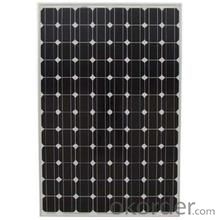
Application
Industrial
Commercial
Residential
Feature
Residential, grid-connected rooftop systems which have a capacity more than 10 kilowatts can meet the load of most consumers.[2] They can feed excess power to the grid where it is consumed by other users. The feedback is done through a meter to monitor power transferred. Photovoltaic wattage may be less than average consumption, in which case the consumer will continue to purchase grid energy, but a lesser amount than previously. If photovoltaic wattage substantially exceeds average consumption, the energy produced by the panels will be much in excess of the demand. In this case, the excess power can yield revenue by selling it to the grid. Depending on their agreement with their local grid energy company, the consumer only needs to pay the cost of electricity consumed less the value of electricity generated. This will be a negative number if more electricity is generated than consumed.[3] Additionally, in some cases, cash incentives are paid from the grid operator to the consumer.
Packaging
With carton and box
- Q: How do solar energy systems impact energy access in developing countries?
- Solar energy systems have a significant positive impact on energy access in developing countries. These systems provide a clean, sustainable, and affordable source of electricity, especially in remote areas where grid infrastructure is limited or non-existent. Solar energy helps bridge the energy gap, enabling communities to power their homes, schools, and businesses, improving their quality of life. Additionally, solar energy systems reduce reliance on fossil fuels, contributing to environmental preservation and mitigating climate change effects.
- Q: Can solar energy systems be used for desalination or water purification?
- Yes, solar energy systems can definitely be used for desalination or water purification. Solar energy can power various technologies that are employed in the process of desalination and water purification, making it a sustainable and renewable source of energy for these purposes. One of the most common methods of desalination is through the use of solar stills. Solar stills are devices that use the energy from the sun to evaporate water, leaving behind salts, impurities, and contaminants. The steam is then condensed and collected, providing fresh water that is free from salinity and impurities. Solar stills are particularly effective in areas where there is ample sunlight and limited access to freshwater sources. Another method is solar-powered reverse osmosis. Reverse osmosis is a process that uses a membrane to remove salts, impurities, and contaminants from water at high pressure. By utilizing solar energy to power the high-pressure pump, this method can effectively produce fresh water from seawater or brackish water sources. Additionally, solar energy can also be used in combination with other water treatment technologies such as ultraviolet (UV) disinfection and advanced filtration systems. UV disinfection uses the energy from ultraviolet light to kill bacteria, viruses, and other microorganisms present in water. Solar-powered UV disinfection systems are not only environmentally friendly but also cost-effective in areas where electricity supply is limited. In summary, solar energy systems can be harnessed to power various desalination and water purification technologies, providing a sustainable and renewable solution to address water scarcity and improve access to clean water.
- Q: Are there any disadvantages to using solar energy systems?
- Yes, there are a few disadvantages to using solar energy systems. Firstly, the initial installation cost can be high, making it less affordable for some individuals or businesses. Secondly, solar panels require a significant amount of space, which may not be feasible for those with limited roof or land area. Additionally, solar energy production is dependent on weather conditions, meaning it may not be as consistent or reliable as other energy sources. Finally, the manufacturing process of solar panels can have some environmental impact, especially in terms of energy consumption and waste generation. However, despite these drawbacks, the long-term benefits of using solar energy, such as cost savings, renewable nature, and reduced carbon emissions, often outweigh these disadvantages.
- Q: Are there any noise concerns associated with solar energy systems?
- Yes, there are minimal noise concerns associated with solar energy systems. Unlike traditional energy sources such as generators or wind turbines, solar panels do not produce any noise while generating electricity. This makes solar energy systems a quiet and peaceful option for harnessing renewable energy.
- Q: Can solar energy systems be used in powering agricultural processing facilities?
- Yes, solar energy systems can be used to power agricultural processing facilities. Solar panels can be installed on the rooftops or surrounding land of these facilities to generate electricity. This renewable energy source can provide a reliable and cost-effective solution to meet the power requirements of various agricultural processing operations, such as drying, milling, refrigeration, and packaging. Additionally, solar energy systems can help reduce greenhouse gas emissions and dependence on fossil fuels, making them an environmentally sustainable choice for powering agricultural processing facilities.
- Q: Can solar energy systems be used in powering recycling plants or waste management facilities?
- Certainly, recycling plants and waste management facilities can make great use of solar energy systems. These systems harness the sun's power to produce electricity, which can then be utilized to operate various equipment and machinery within these facilities. It is worth noting that these facilities require a significant amount of energy to power their operations, including machines for sorting and processing, conveyor belts, and other equipment. By installing solar panels on the roofs or in close proximity to these facilities, they can generate clean and renewable electricity, thus reducing their dependence on conventional energy sources. Solar energy systems offer numerous advantages for recycling plants and waste management facilities. Firstly, they provide a reliable and consistent source of energy, as the sun is readily available in most regions throughout the year. In contrast to fossil fuels or other non-renewable sources, solar energy systems do not deplete natural resources or contribute to greenhouse gas emissions, making them environmentally friendly. This aligns perfectly with the sustainability goals of recycling plants and waste management facilities, which aim to minimize the environmental impact of waste management processes. Moreover, solar energy systems can help these facilities save on energy costs. Once the initial investment in solar panels is made, the ongoing operational expenses are relatively low. Additionally, certain regions offer incentives and financial support for the installation of solar energy systems, further offsetting the initial investment and making it financially attractive. Furthermore, recycling plants and waste management facilities often possess ample surface areas suitable for solar panel installations, such as rooftops or open fields. This facilitates the installation of a sufficient number of solar panels to meet the energy demands of these facilities. In some cases, surplus energy generated by the solar panels can even be fed back into the electrical grid, enabling the facilities to generate revenue from the excess electricity. In conclusion, solar energy systems can effectively power recycling plants and waste management facilities. They present a sustainable and cost-effective solution, reducing dependence on traditional energy sources while aiding these facilities in achieving their environmental objectives.
- Q: How does the efficiency of solar panels vary based on the manufacturer?
- The efficiency of solar panels can vary based on the manufacturer due to several factors. One significant factor is the quality of materials used in the production of the panels. Different manufacturers may use different types of silicon, which is the primary material in most solar panels. High-quality silicon can capture and convert more sunlight into electricity, resulting in higher efficiency. Another factor is the manufacturing process itself. Each manufacturer may have different techniques and technologies for producing solar panels. Advanced manufacturing processes can lead to more precise and uniform panel construction, reducing any potential losses in energy conversion and improving overall efficiency. Furthermore, research and development investments play a crucial role in the efficiency of solar panels. Manufacturers that invest in continuous research and development can develop innovative technologies, such as anti-reflective coatings or multi-junction cells, that can significantly enhance the efficiency of their panels. Moreover, the size and design of solar panels can vary among manufacturers. Larger panels with more surface area can capture more sunlight, while innovative designs can optimize energy absorption and minimize losses due to shading or environmental factors. Different manufacturers may have different panel sizes and designs, impacting their efficiency. Lastly, the reputation and experience of a manufacturer can also influence the efficiency of their solar panels. Established manufacturers with a track record of producing high-quality and efficient panels are likely to have refined their production processes and incorporated lessons learned from previous models, resulting in improved efficiency. Overall, the efficiency of solar panels can vary based on the manufacturer due to differences in materials, manufacturing processes, research and development efforts, panel size and design, as well as the reputation and experience of the manufacturer. It is important for consumers to research and compare different manufacturers to select panels with the highest efficiency suitable for their specific needs.
- Q: What are the advantages of using solar energy systems?
- There are several advantages of using solar energy systems. Firstly, solar energy is a renewable and abundant source of energy. It is derived directly from the sun, which means it will never run out. Secondly, solar energy systems are environmentally friendly as they produce zero greenhouse gas emissions during operation, reducing our carbon footprint and combating climate change. Additionally, solar energy systems require minimal maintenance, resulting in lower operating costs compared to traditional energy sources. Moreover, installing solar panels on rooftops can help households and businesses save money on their electricity bills by generating their own clean and free energy. Finally, solar energy systems can provide energy independence, reducing reliance on fossil fuels and the risks associated with fluctuating energy prices.
- Q: Can solar energy systems be integrated with existing electrical systems?
- Yes, solar energy systems can be integrated with existing electrical systems. They can be connected to the grid or used in standalone systems, depending on the specific requirements and goals of the user. Integration typically involves the installation of solar panels, inverters, and other necessary equipment to convert sunlight into usable electricity. This integration enables the generation of renewable energy and reduces reliance on traditional power sources.
- Q: Can a solar energy system be used in areas with high levels of dust or sand?
- Yes, a solar energy system can still be used in areas with high levels of dust or sand. However, the efficiency of the system may be affected as the accumulation of dust or sand can reduce the amount of sunlight reaching the solar panels. Regular cleaning or maintenance may be required to ensure optimal performance of the system in such environments.
Send your message to us
Active and Passive Solar Energy Systems - CNBM On Grid System 6000W with Certificate UL TUV CE
- Loading Port:
- Shanghai
- Payment Terms:
- TT OR LC
- Min Order Qty:
- 100 watt
- Supply Capability:
- 1000 watt/month
OKorder Service Pledge
OKorder Financial Service
Similar products
Hot products
Hot Searches
Related keywords
